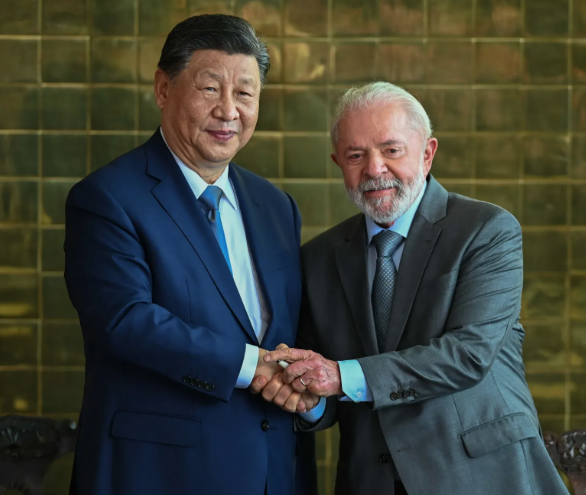Brazilian President Luiz Inacio Lula da Silva is taking bold steps to strengthen ties with China, even as trade tensions grow between the United States and China.
Brazil Grows Closer to China, Not Backing Down from U.S. Pressure
Lula has made it clear that he doesn’t want to choose sides in the ongoing trade war between the world’s two largest economies. However, his recent actions show that if he had to pick, he would lean toward China.
This week, Lula is visiting China for another high-level meeting with President Xi Jinping. It’s their third official meeting since 2023. The two leaders are expected to sign new trade agreements that will help open Chinese markets to more Brazilian products, especially agricultural goods like corn, coffee, and beef.
In return, China plans to invest in Brazil’s infrastructure. This includes building roads, railways, and ports to help transport goods more efficiently from Brazil to China and other Asian markets. One major project under discussion is a transoceanic railway that would connect Brazil’s Atlantic coast to a Peruvian port on the Pacific Ocean. That port, Chancay, is already owned by a Chinese company and is expected to become a key hub for exports.
Lula told business leaders in Beijing that he sees China and Brazil as “unavoidable partners” and wants their relationship to be “indestructible.” Brazil’s foreign ministry claims that last year’s trade between the two countries totaled $158 billion, nearly twice as much as that between Brazil and the United States.
China Invests Big in Brazil’s Growth
Chinese interest in Brazil goes beyond buying goods. China is also becoming one of the biggest investors in Brazil’s economy. On the eve of Lula’s visit to China, a group of Chinese companies announced plans to invest 27 billion reais (around $4.7 billion) in Brazil over the next few years.
Brazil’s Bold Rejection of China’s Influential BRI Sparks Economic Debate
These investments cover several areas. For example, Great Wall Motor (GWM) and BYD, two major Chinese car companies, are helping revive Brazil’s auto industry by producing electric vehicles. Sales of electric and hybrid cars in Brazil jumped nearly 90% in 2024. Sixty-one percent of the 177,000 cars sold were from Chinese manufacturers, primarily BYD and GWM.
China is also entering other industries in Brazil. Shenzhen Longsys Electronics plans to open new semiconductor factories. Meanwhile, Chinese fast-food giant Mixue Group and a delivery app called Keeta are also setting up operations in Brazil.
Instead of officially joining China’s Belt and Road Initiative—a global infrastructure plan—Lula has chosen to work closely with China through other means. He created a task force to keep regular contact with Chinese officials, focusing on business deals and big projects like the railway to Chancay. Most of Brazil’s new transport infrastructure will connect to that port, helping speed up exports to China and Asia.
Brazil Uses BRICS to Challenge U.S. Trade Tactics
Lula’s closer ties with China also show up in Brazil’s global policies. Brazil has voiced opposition to U.S. trade activities, particularly those associated with Donald Trump’s policies, as have China and other BRICS nations (South Africa, India, Russia, and a few others).
Brazil’s Espionage Against Paraguay Triggers Diplomatic Fallout and Itaipu Dam Dispute
The group issued a statement denouncing “unjustified unilateral protectionist measures” during a BRICS meeting in Rio de Janeiro. This clearly alluded to recent trade actions by the United States, such as the imposition of high tariffs. Although the statement didn’t name Trump directly, it was clearly aimed at his approach to trade. Lula has backed this message, aligning Brazil with China and other BRICS nations in pushing back against U.S. protectionism.
Despite Brazil’s growing relationship with China, the U.S. has largely remained silent. While American diplomats have focused on other Latin American countries, they haven’t engaged much with Brazil recently. Lula’s government continues to strengthen its partnership with Beijing, showing little concern for Washington’s lack of involvement.
Meanwhile, Brazil is using the trade war to its advantage. With Chinese demand rising and U.S. products becoming more expensive due to tariffs, Brazil is stepping in to fill the gap. More than 150 Brazilian agribusiness executives will travel to China later this month. They will attend Asia’s largest food trade fair in Shanghai and hold meetings to expand exports—an effort Lula has supported as part of his broader economic strategy.
Luis Rua, a top official in Brazil’s agriculture ministry, said that now is the time to show China that Brazil is ready and willing to be a reliable trade partner. “It’s crucial that we show our faces right now so that the trade partner, including the decision-makers, knows Brazil is present,” Rua said.
Lula’s visit to China, the signing of new agreements, and increasing investment from Chinese companies all show that Brazil is moving forward with China, even as the U.S. tries to maintain influence in Latin America. The relationship is growing stronger, with both sides benefiting from trade, development, and cooperation—despite the ongoing tensions in global politics.

